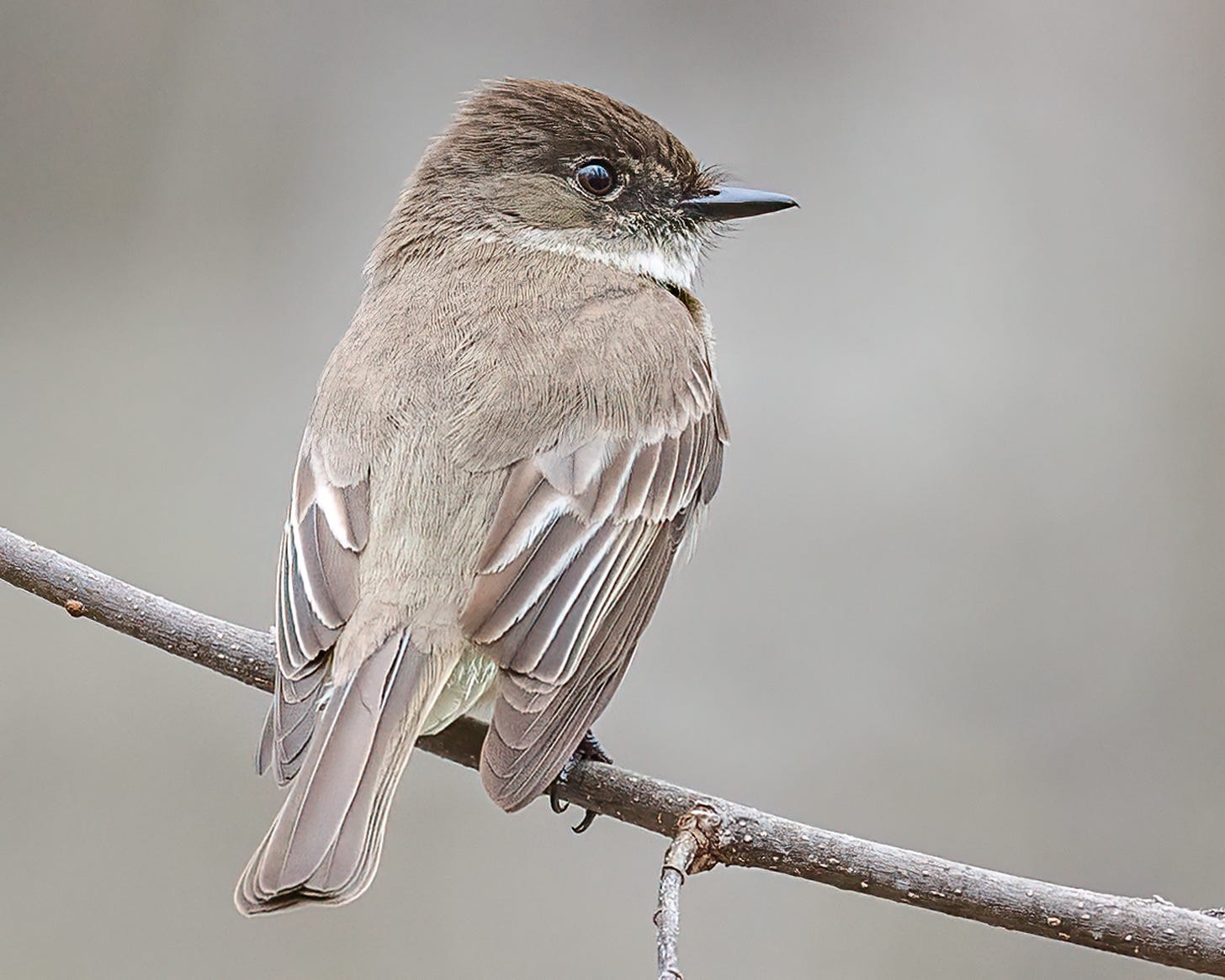Eastern Phoebes are a bird for discerning and mature admirers who appreciate subtlety and a steady presence. They invite a closer look. The folly of youth, blowing like a flower in the wind, predisposes us to pursue flashy birds. Warblers attract young attention with their ephemeral nature, bright color, and constant motion. They are with us briefly as part of their constant travels. When I was young I chased rarities and warblers and still do on occasion, but I am largely in a phoebe state of mind these days, which is to say, that I appreciate any bird that is near me.
I also appreciate the benefits of being in my 50s and the solidity of maturity, hanging steady like ripe fruit, still full of promise and unexplored potential, but now more open to beauty. In this phase of my life, I intentionally cultivate the ability to admire subtle common birds like the Eastern Phoebe.
The Eastern Phoebe is various shades of gray and white with a subtle yellow stripe that runs down the center of his breast. He repeats his name when he sings. He is also relatively tolerant of people and full of mystery and contradictions. Phoebes are one the first migrants to return to our area in the spring. They arrive in song and quickly form pair bonds. During this time, males perform a flight song, where they fly up into the air and circle an area with slow fluttering wing beats while giving a series of chips, squeaky notes, and fragments of their song. Some of the notes remind me of the Woodcock flight song. If they are successful in attracting a female, they form a pair bond and start nest-building in early April. One of the surprising aspects of this is that phoebes are a flycatcher, meaning that most of their diet consists of insects that they snatch out of the air.
Not many insects fly around in late March, and we can still experience lows in the 20s and highs in the 30s this time of year. Phoebes adapt by eating fruit and seeds during cold spells. They have also been documented diving into water like tiny kingfishers and catching small fish.
One of the reasons that they return so early is that there is intense competition for nest sites. Phoebes are tolerant of people and have adapted to nest on buildings, bridges, and culverts. They are particularly fond of I-beams. They also like to be near flowing water and woody cover. This means there are a limited number of suitable nest sites for them, and the birds that show up early are more likely to gain access to a good location.
Their tolerance of us and propensity for nesting on our structures allows for a close relationship to develop as noted in this intimate poem.
Bird on Knee
There was a man who filmed
a wild bird perched lightly
on his knee, an eastern phoebe,
and how I wish it had been me
to receive a little sign
the tide might turn, shift.
Think my rod, my staff, the craft
of conjuring a little belief,
a field of grass, a clear horizon line.
Goodness is not the key,
but comfort and small things
that land softly, stun the breath,
let you have a thrill just long enough
where the knee quivers,
and a bird shifts accordingly.
Tara Bray
One of our local parks has two foot bridges that span Sugar Creek. The bridges are supported by I-beams, and phoebes build their nest on the I-beam over the creek. They like to pick a corner near the end of the bridge where the wooden planks are right above the top of the nest.
Phoebes can also build nests that adhere to the side of a structure. They begin nest building by hovering and flicking mud against the wall until they have built up a base that can serve as a perch where they can land and finish the mud foundation before adding grass, twigs, and hair and finishing off the outside with green moss. They are rewarded for their hard work and nest site preferences by having relatively high nest success. Phoebes have expanded their range in some areas, and they are generally considered to have stable or increasing populations.
If you have suitable habitat, you can build a nesting platform for phoebes and other birds like Mourning Doves and American Robins. They will nest under the eaves of a house, barn, or other structure like a wood shed or old corn crib. If you succeed in attracting phoebes, the same birds may return for six years or more.
The Coming Of Phoebe
When buckets shine ‘gainst maple trees
And dropp by dropp the sap doth flow,
When days are warm, but still nights freeze,
And deep in woods lie drifts of snow,
When cattle low and fret in stall,
Then morning brings the phoebe’s call,
‘phoebe,
phoebe, phoebe,’ a cheery note,
While cackling hens make such a rout.
When snowbanks run, and hills are bare,
And early bees hum round the hive,
When woodchucks creep from out their lair
Right glad to find themselves alive,
When sheep go nibbling through the fields,
Then phoebe oft her name reveals,
‘phoebe,
phoebe, phoebe,’ a plaintive cry,
While jack-snipes call in morning sky.
When wild ducks quack in creek and pond
And bluebirds perch on mullein-stalks,
When spring has burst her icy bond
And in brown fields the sleek crow walks,
When chipmunks court in roadside walls,
Then phoebe from the ridgeboard calls,
‘phoebe,
phoebe, phoebe,’ and lifts her cap,
While smoking Dick doth boil the sap.
John Burroughs
A reader shared this beautiful song with me about phoebes, moonlight, and other common delights.










Jud Caswell’s Phoebe on the Fencepost went perfectly with your post today! Beautiful and gentle grace.
You’re speakin’ my language.